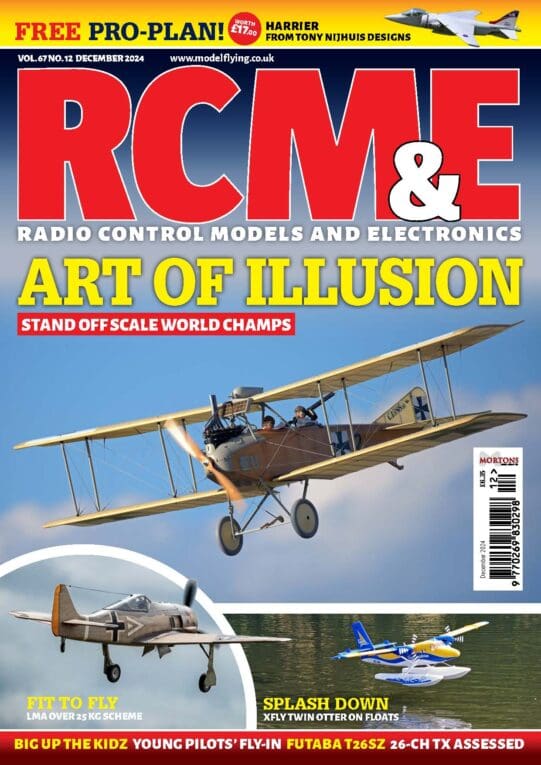Time to wrap things up, so it’s off to the hill to see how this stylish glider handles. If you haven’t done so already, be sure to take a look at Parts One and Two of this review.
The Erwin is billed as a bit of an all-rounder more of a top-end sport model than a racer or full-on heavy DS tool and it fulfils this role very well. However, rigging the model on your own in a blustery car park on the side of the hill isn’t easy! The wing sits quite precisely onto the seat, but managing to hold all this together whilst looking for the end of the Sellotape and successfully wrapping it 6 times around the fuselage to hold the wing on is frustrating at best. Try asking one of your mates for assistance after they’ve stopped laughing at your attempts to do it alone.
The turbulent ‘all blow and no go’ conditions of the day saw even well-sorted models scraping slowly around tail down, and I threw the model out of desperation rather than common sense. Still I did manage to tweak the CROW mix a little and discovered that the C of G was slightly too far forwards. Here’s the procedure for removing a little nose weight: un-tape the wing, disconnect the wiring loom and set the wing aside. Remove the taped-on linkage cover at rear of fuselage and set aside. Disconnect the pushrod ball links from the elevator horns. Unscrew the two 5mm nylon bolts from servo tray and set aside.
Enjoy more RCM&E Magazine reading every month.
Click here to subscribe & save.
Remove the switch harness from the inner fuselage nose section, being careful not to lose the screws. Release the Rx aerial wire from fuselage side and partially withdraw the servo tray. Remove the elevator pushrod clevises from the servo arms. Withdraw the pushrods to the rear of the model to permit removal of the servo tray. Take out the servo tray and extract the lead as required. Partially replace the tray and re-attach the pushrod ends to the servos. Fully install the tray and secure with 5mm nylon bolts. Re-route the aerial wire, replace the switch and re-attach the ball links to the elevator horns. Nearly there now! Replace the outer linkage fairing with tape, re-connect the wing wiring loom and, finally, re-tape the wing to the fuselage. Nice job on a cold, wet hillside! Of course, you can add lead to the tail and make it good on the bench later, but you get my point.
Fiddling aside, the Erwin is a very slippery ship. Easy to hold and launch on your own in even quite strong winds and quite pacey. With that efficient Quabeck aerofoil the model responds exceptionally well to camber, reflex and snap-flap with minimal trim change at the back end. Even unballasted, she penetrates strong winds very quickly with the wing t.e. flicked up slightly.
It can’t half crack a turn, too. Very grippy, but beware of too much elevator throw or it will let go. In fact in consecutive loops the elevator does feel sluggish compared to the ‘ping’ available for a racing turn.
In lighter air the Erwin soars very well. Once again the camber plays an important role in keeping the wing working. It’s not the happiest thermal soarer I have and you do need to rudder-balance the turns somewhat when locked into lift, but overall it’s none too shabby. With 14oz of ballast squeezed between the wing joiners the model really comes alive, and the very best can then be extracted from the slippery airframe. The massive flaps stop it dead in its tracks under CROW braking, even with full lead on board.
SPORTING DS
My assumptions were correct about dynamic soaring. Here the Erwin is fairly stable but you always have the impression that it’s not strong enough for serious speeds. Not the wing as such, more the fuselage and tailplane. The elevators with their lack of gap seals squeal in agony when the model starts to push 130mph. Sounds great mind you, and it’s not the quietest model on the hillside with the wipers on the top. A pretty good sporting DS toy, but far too pretty to bounce of the hillside just for a speed buzz.
The recommended coupling of the flaps to the ailerons for increased roll control is well founded. The ailerons alone are fine in fast DS but sluggish on the front side. With the flaps kicked in, roll rate is much more along the lines of a quick 60″ model and I actually had to introduce some exponential to be happy with my course corrections.
WATCH OUT
Visually, the model is unnerving. The flat wing takes on an air of anhedral at some angles and the lack of colour is fine above the horizon, but drop below and you start to struggle. Get the model against a dark field or dry stone wall on a murky day and you might get a little twitchy over its whereabouts. If you’re easily distracted as you fly there’s nothing to stop you adding a bit of girlie pink trim to the upper tips, especially if paying extra for a full top colour irks you. If you don’t get on with it after that, you can always hang it on the wall at home for decoration! It really does do it for me, all that visible carbon. The Erwin’s definitely a boy’s toy, in the greatest sense.
ORDER UP
The Erwin 5 DS is available in the UK only from T9Hobbysports at www.t9hobbysport.com priced at £355 for a standard carbon version or £375 for the DS version. Both are full carbon. Extra colour on the top surface only will be an additional £35, and shiny heat reflective wing bags are also available for £35.




